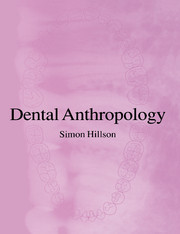Book contents
- Frontmatter
- Contents
- Acknowledgements
- Abbreviations
- 1 Introduction to dental anthropology
- 2 Dental anatomy
- 3 Variation in size and shape of teeth
- 4 Occlusion
- 5 Sequence and timing of dental growth
- 6 Dental enamel
- 7 Dentine
- 8 Dental cement
- 9 Histological methods of age determination
- 10 Biochemistry of dental tissues
- 11 Tooth wear and modification
- 12 Dental disease
- 13 Conclusion: current state, challenges and future developments in dental anthropology
- Appendix A: Field and laboratory methods
- Appendix B: Microscopy
- References
- Index
6 - Dental enamel
Published online by Cambridge University Press: 05 June 2012
- Frontmatter
- Contents
- Acknowledgements
- Abbreviations
- 1 Introduction to dental anthropology
- 2 Dental anatomy
- 3 Variation in size and shape of teeth
- 4 Occlusion
- 5 Sequence and timing of dental growth
- 6 Dental enamel
- 7 Dentine
- 8 Dental cement
- 9 Histological methods of age determination
- 10 Biochemistry of dental tissues
- 11 Tooth wear and modification
- 12 Dental disease
- 13 Conclusion: current state, challenges and future developments in dental anthropology
- Appendix A: Field and laboratory methods
- Appendix B: Microscopy
- References
- Index
Summary
Dental enamel coats the crown with a heavily mineralized layer that can be over 2 mm thick over unworn cusps of permanent molars, decreasing to 1 mm down the crown sides and a fraction of that at the cervix. Deciduous teeth typically have much thinner enamel than permanent (1 mm or less). For a review of enamel structure and physiology, see Boyde (1989).
Enamel formation
Enamel is itself non-cellular, but is formed by the internal enamel epithelium (page 118), a sheet of closely and regularly packed cells called ameloblasts. Formation proceeds in two stages:
Matrix secretion. Enamel matrix is one-third organic and one-third mineral (page 227, Table 10.1). Filament-like apatite crystallites, each 30 nm in diameter, are seeded into the matrix and grow with orientations that depend upon the shape of each ameloblast and the packing of the cell sheet as a whole. During the bulk of matrix secretion, the ameloblasts bear a protuberance on their ends called Tomes' process. If the ameloblast layer is pulled away from the developing matrix surface, the Tomes' processes leave a hexagonal network of pits. Crystallites seeded in the pit floors grow with a different orientation to those in the walls, to create discontinuities that extend through the matrix.
[…]
- Type
- Chapter
- Information
- Dental Anthropology , pp. 148 - 181Publisher: Cambridge University PressPrint publication year: 1996
- 1
- Cited by



